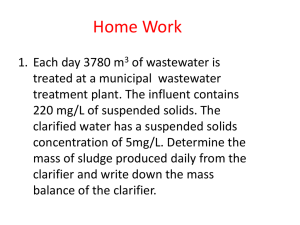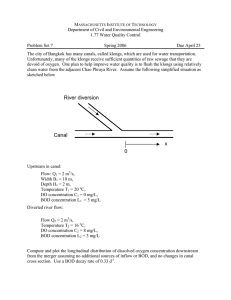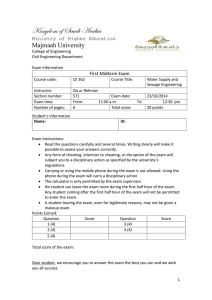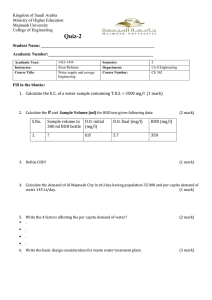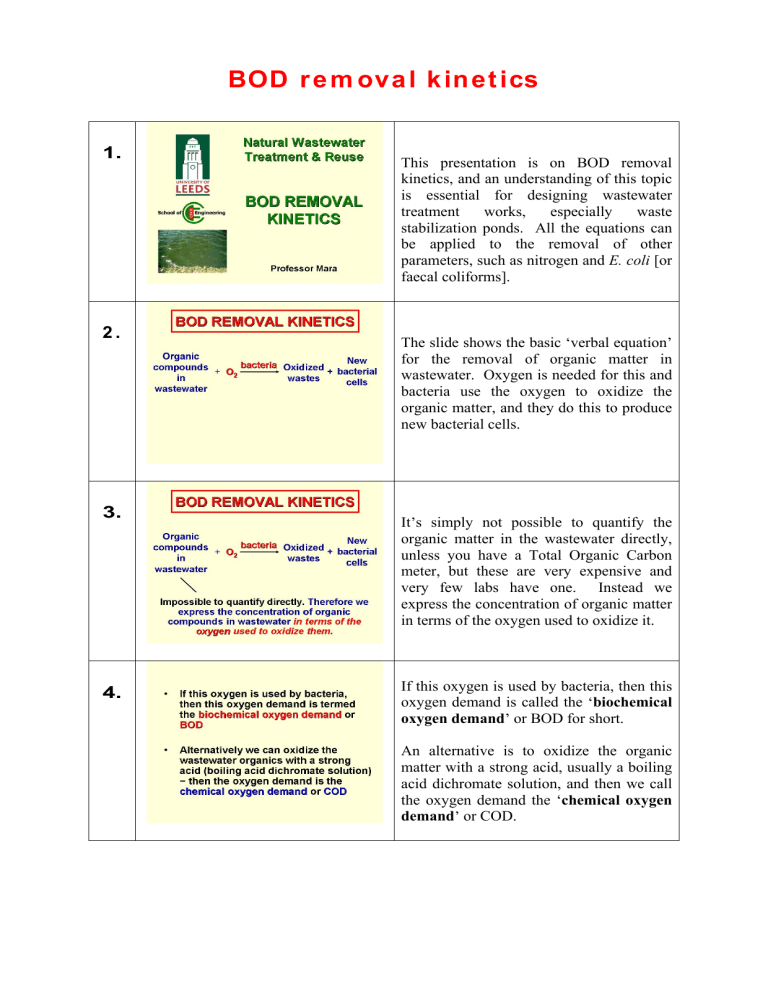
BOD r e m ova l k in e t ics 1. 2. 3. 4. This presentation is on BOD removal kinetics, and an understanding of this topic is essential for designing wastewater treatment works, especially waste stabilization ponds. All the equations can be applied to the removal of other parameters, such as nitrogen and E. coli [or faecal coliforms]. The slide shows the basic verbal equation for the removal of organic matter in wastewater. Oxygen is needed for this and bacteria use the oxygen to oxidize the organic matter, and they do this to produce new bacterial cells. It s simply not possible to quantify the organic matter in the wastewater directly, unless you have a Total Organic Carbon meter, but these are very expensive and very few labs have one. Instead we express the concentration of organic matter in terms of the oxygen used to oxidize it. If this oxygen is used by bacteria, then this oxygen demand is called the biochemical oxygen demand or BOD for short. An alternative is to oxidize the organic matter with a strong acid, usually a boiling acid dichromate solution, and then we call the oxygen demand the chemical oxygen demand or COD. 5. 6. 7. The COD of a wastewater is always greater than its BOD because the COD is due to both the biodegradable and the nonbiodegradable compounds present, whereas the BOD is due only to the biodegradable compounds. Both COD and BOD are expressed as concentrations, usually mg/l or g/m3; strictly speaking, the units should be g O2/m3. Most commonly we use a first-order equation to represent BOD removal. The equation in its differential form is: dL = k1 L dt where L is the BOD in mg/l; t is time, usually in days; and k1 is the first-order rate constant for BOD removal and it has dimensions of reciprocal time, usually day 1. This equation, which is valid for aerobic reactors in which oxygen is not limiting, basically says that the rate of BOD removal (dL/dt) at time t is proportional to the amount of BOD (L) still to be removed at that time. We can integrate this equation to: L = Lo e- k1t where Lo is the amount of BOD present at t = 0, often called the ultimate BOD or BODu. If y is taken as (Lo L), where y is the amount of BOD removed at time t, then: y = Lo(1 e- k1t ) and if t = 5 days, then y5 is the amount of BOD removed in 5 days or the amount of oxygen the bacteria have used in 5 days. This is a basic concept because when we talk about BOD we are usually referring to the 5-day BOD, in fact at 20°C, or BOD5. 8. 9. These two graphs are typical BOD curves. The one on the left is the y t curve showing how the BOD is removed, that s the same as how the bacteria use the oxygen; and the one on the right is the L t curve showing how much BOD remains at any time t. The y t curve starts at zero, and the L t curve starts at Lo. The two curves are showing the same thing, of course, as y = Lo L. The ratio BOD5/BODu, or y5/Lo, is given by: y5/Lo= (1 e-( k1 5) ) For normal untreated domestic or municipal wastewater k1 is ~0.23 day 1, so the ratio is ~ . We normally measure BOD5, so we know that the ultimate BOD will be ~1.5 × the BOD5. 10. 11. k1 is really a reflection of bacterial activity, so it will vary with temperature. To describe this we use an Arrhenius-type equation, usually of the form: k1(T) = k1(20) T 20 where k1(T) is the value of k1 at T°, k1(20) its value at 20°, and is an Arrhenius constant and, for BOD removal, it s often in the range 1.03 1.09 and typically ~1.05. The equations we ve developed so far are batch culture equations that is to say, they re for a given volume of wastewater which receives no more wastewater and there s no discharge of treated wastewater from it. But wastewater treatment plants are continuous flow reactors, not batch reactors, as they receive an inflow of wastewater all the time and there s a corresponding outflow of treated wastewater. In a reactor there are three types of hydraulic flow regime: complete mixing, plug flow and dispersed flow. The first two are ideal flow regimes and are never totally achieved in practice. 12. We ll look first at complete mixing. With this ideal flow regime the influent is completely and instantaneously mixed with the reactor contents, and this means that the effluent from the reactor is identical in every respect to the reactor contents. So, if we have a reactor of volume V receiving an influent flow Q of wastewater which has a BOD of Li, and if the effluent BOD is Le, then 13. we can do a BOD mass balance across the reactor, which simply says that what goes in equals what s been removed + what goes out. The BOD that goes in is LiQ g/day; the BOD that goes out is LeQ g/day; and the BOD that s removed in the reactor is k1LeV g/day. So: LiQ = LeQ + k1LeV [See Note at end of transcript] 14. We can rearrange this equation as shown on the slide, and then writing V/Q as , the mean hydraulic retention time, we get: Le = 15. Li 1 k1 The other ideal flow regime is plug flow and this can be visualised as a very long, narrow reactor, like a river for example; and for this type of reactor the effluent is not the same as the reactor contents as these vary along the reactor length. Another way of looking at a plug-flow reactor is to imagine the wastewater in packets travelling discretely and uniformly along the reactor as if on a conveyor belt. There s complete mixing within each packet but no inter-packet mixing. Thus BOD removal in each packet is just like removal in a batch reactor and so we can use the equation for L that we developed earlier but write it in terms of Li and Le; thus: Le = Li e- k1t 16. 17. 18. 19. In reality, of course, we don t have either of these two ideal flow regimes; we have what s called dispersed flow and dispersed-flow reactors are characterised by a dispersion number given the symbol . The value of is between zero and infinity. In a plug-flow reactor = 0 and in a completely mixed reactor = . In dispersed flow reactors 0< < and BOD removal is described by the WehnerWilhelm equation shown on the slide. The equation may look a bit complicated, but it s not really. This slide shows the Thirumurthi chart for dispersed-flow reactors. On the y axis we have the dimensionless product k1 and on the x axis, on a log scale, the percentage BOD remaining. For plug flow, i.e. for = 0, we have a straight line; and for all other values of we have slightly curved lines. Several lines are on the chart and the corresponding dispersion number is adjacent to each. If we look at 20% BOD remaining on the x axis and go up, we find that the value of k1 is somewhere around 0.7 or so for plug flow; and more or less exactly 4 for complete mixing. This might suggest that plug-flow reactors are far more efficient than completely mixed reactors, and most people hold to this view. It s certainly true if the value of k1 is the same in both types of reactor, both treating of course the same wastewater; but this may not generally be the case. For dispersion numbers less than 2 (and with dispersion numbers 2 is actually quite close to ), the second term in the denominator of the Wehner-Wilhelm equation is small and can be ignored, so that for most reactors the equation becomes: 1 a Le 4a 2 e Li (1 a ) 2 where a = (as before) [1 + 4k1 ]½. We can measure from tracer studies or, just for waste stabilization ponds, we can get an estimate of from von Sperling s equation, which says that is the reciprocal of the pond s length-tobreadth ratio. 20. 21. 22. Tracer studies are done like this. At t = 0 a concentrated slug of the tracer, usually a dye such as rhodamine WT, is poured into the pond, as shown on the slide for the fullscale facultative pond at Vidigueira in Portugal. Then the concentration of the dye in the effluent is measured for 2 3 V/Q retention times. The results can then be fed into a computer program to calculate . With facultative and maturation ponds we often find that is ~0.4 0.8, i.e. roughly half way between plug flow and complete mixing, which is what you d sort of expect. This slide shows four plots of dimensionless concentration against dimensionless time. Dimensionless concentration is Ce/C*, where Ce is the dye concentration in the effluent and C* is the mass of dye added in the slug divided by the pond volume. Dimensionless time is te, the time at which Ce is measured, divided by the V/Q retention time, . The four plots are for complete mixing or = , at top left; for plug flow or = 0, at bottom right; and for a high degree of dispersion, = 0.2, at top right; and a low level of dispersion, = 0.002, at bottom left. With complete mixing Ce/C* = 1 at t = 0; thereafter the dye is washed out exponentially. In complete contrast, with plug flow all the dye appears in the effluent at the same time and this time is , the V/Q retention time when the dimensionless time ratio te/ = 1. For the low level of dispersion some dye appears in the effluent before te/ = 1 and some after, but most appears pretty close to when te/ = 1. For the high degree of dispersion a small amount of dye appears almost immediately; then it builds up to a peak, after which it decreases, not quite exponentially but almost so. This is the type of curve we most commonly encounter with waste stabilization ponds. © Duncan Mara 2006 ____________ Note Slide #13: The BOD removed in a completely mixed reactor in grams per day is derived as follows: 1. The rate of BOD removal is dL/dt and this equals k1L, with the minus sign merely indicating that L decreases with t. 2. L is the BOD of the reactor contents which, for a completely mixed reactor, is the same as the effluent BOD, Le. So dL/dt = k1Le. 3. Writing dL/dt = k1Le on a finite-time basis for the whole reactor: L/ t = k1LeV 4. Thus the BOD removed is | k1LeV| = k1LeV g/day.

